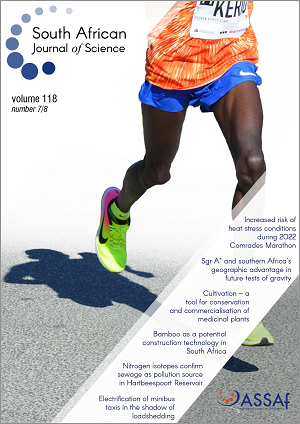Modelling water temperature in the lower Olifants River and the implications for climate change
DOI:
https://doi.org/10.17159/sajs.2022/12953Keywords:
climate change, freshwater rivers, statistical models, water temperature, modellingAbstract
Freshwater systems in southern Africa are under threat of climate change, not only from altered flow regimes as rainfall patterns change, but also from biologically significant increases in water temperature. Statistical models can predict water temperatures from air temperatures, and air temperatures may rise by up to 7 °C by 2100. Statistical water temperature models require less data input than physical models, which is particularly useful in data deficient regions. We validated a statistical water temperature model in the lower Olifants River, South Africa, and verified its spatial applicability in the upper Klaserie River. Monthly and daily temporal scale calibrations and validations were conducted. The results show that simulated water temperatures in all cases closely mimicked those of the observed data for both temporal resolutions and across sites (NSE>0.75 for the Olifants River and NSE>0.8 for the Klaserie). Overall, the model performed better at a monthly than a daily scale, while generally underestimating from the observed (indicated by negative percentage bias values). The statistical models can be used to predict water temperature variance using air temperature and this use can have implications for future climate projections and the effects climate change will have on aquatic species.
Significance:
- Statistical modelling can be used to simulate water temperature variance from observed air temperature, which has implications for future projections and climate change scenarios.
- While there are many other factors affecting water temperature, air temperature accounts for up to 95% of water temperature variance.
- The model used can successfully simulate water temperature variance for different rivers.
Published
Issue
Section
License

All articles are published under a Creative Commons Attribution 4.0 International Licence
Copyright is retained by the authors. Readers are welcome to reproduce, share and adapt the content without permission provided the source is attributed.
Disclaimer: The publisher and editors accept no responsibility for statements made by the authors
How to Cite
- Abstract 449
- PDF 569
- EPUB 185
- XML 177












.png)